In my first game of Brave New World, I mentioned the trade route mechanics as an awkward and not really adequate substitute for the traditional method of earning gold from regular terrain production. But that game perhaps wasn't a great judge of the system. I wanted to play a game fully focused on the trade route mechanics as the leading component, to see and fully understand it.
And trade routes call for efficient and useful ways to spend the gold. With the new Order ideology of Skyscrapers for -33% building purchase cost, multiplicatively stacked with Big Ben (-15%) and Mercantilism (-25%), you can get all the way to 60% cost reduction! For a win condition, I guess space is the highest end conclusion with time for all that late game efficiency to work. Although I know I won't be beating any space speed records without the Rationalism tree.
I actually made two attempts at this game plan. I played one game halfway through, click here for the report if you like. This game made a number of mistakes that I wasn't happy with.
- I tried Morocco first, as the most obvious trade route oriented civilization, with a unique bonus of +3 gold per gold trade route. This actually didn't work so well; it's not enough to matter, you don't want gold routes early over food or production routes, and gold routes aren't that good until the purchase discounts kick in.
- I tried an Archipelago map first. The problem here is that this map doesn't generate enough coastal connectivity between the islands. I wasted tons of time sailing settlers along long circuitous coastal routes. Tiny Islands is better with much more coastal connectivity.
- I opened Tradition, which is actually a mistake on an island map. The food bonuses are useless when they just grow your cities onto piles of useless ocean tiles.
- And I tried the Exploration policy tree before Commerce, for Maritime Infrastructure (+3 production in coastal cities) and then also needed Naval Tradition for happiness. This was a mistake in pushing Mercantilism and Protectionism much too far back.
So I didn't like how that was going, and restarted with a much better overall plan. Here are the key points:
- Indonesia for the civilization, not Morocco. I looked up how Indonesia actually works: each of its first three island cities gets two copies of one of three unique spice luxury resources. Morocco's trait tops out at about 18 gpt with six trade routes. Indonesia could sell all the luxes for 42 gpt, or later can keep some of the happy for yourself.
- Liberty not Tradition, which gives production rather than food which is what you need. Also Liberty is better for frontloaded partial investment.
- Get quickly to the Commerce opener and to Mercantilism in time to buy settlers. Buying settlers is significant leverage on island maps, since you can buy them in the right spots to minimize travel time. Settlers are already the best items to buy early on, with a gold/hammer ratio on par with most buildings, with the additional advantage of circumventing the no-growth restriction. (The same reason they were the best items to rush in Civ 4.)
- And get quickly to Protectionism to fix the happy crunch. Indonesia has great synergy here with the extra luxuries. But screwing around in Exploration wasn't making that work. I expect this policy should yield like 20 or 24 happiness, but you need to bulldoze Commerce all the way to get it early enough to matter.
- Finally, get quickly to Metal Casting for those production trade routes. Those are the best usage of the trade route slots. Gold from foreign routes is far less productive before Mercantilism and merely vaguely competitive even with it. Money trade routes can't really compete until after Big Ben and the Skyscrapers ideology.
I didn't like my first map roll, which was a tundra dud. So once the kitty is broken by rerolling once, you may as well take several rerolls to find something good.
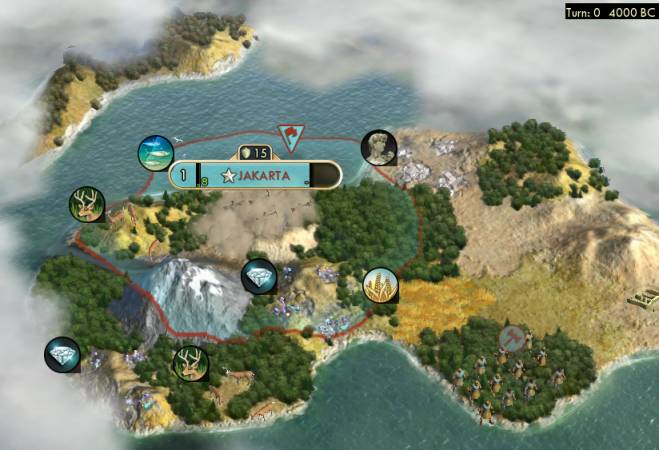
Got this one after about ten tries. Nice tight cluster of good stuff, food resources, hills for production, luxuries, river, and a mountain for Machu Picchu and observatory.
Pottery first, since the granary will be +5 food! And worker first, we don't need scouts on a pelago, and I actually want culture to come slow to save policies for Commerce.
Mining second, while building the granary.
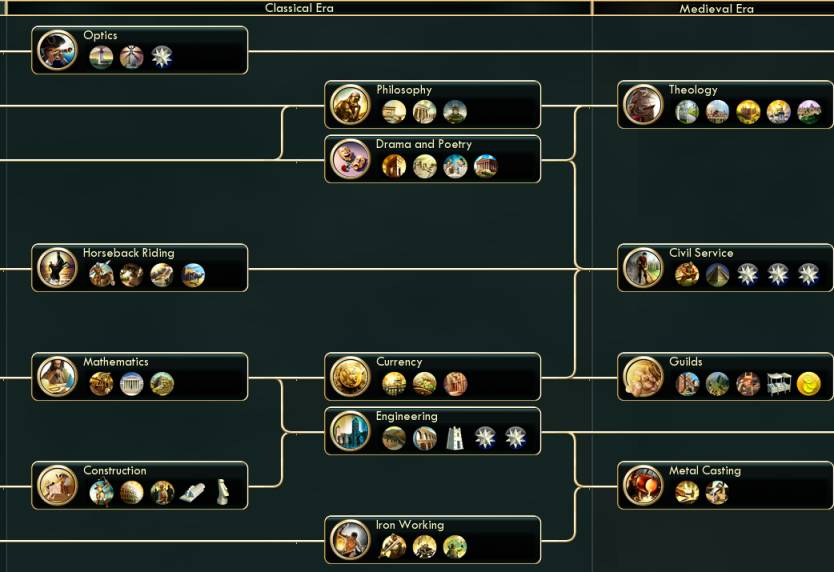
Now I spent quite a while (a half hour) trying to figure out a good plan to use the Great Library to jump ahead to the medieval era for the Commerce tree. But no matter how I arranged it, there just wasn't a good enough path quickly enough. The fastest path to medieval is Great Library for Philosophy, then the National College at one city, both boosting research and using the short path at Theology. But... all those techs don't really DO anything if it's not a focused religious game plan. The next fastest way to medieval is Guilds, with some value in the techs (fast East India Company), but still not a whole lot there. The medieval entry route I really want is Metal Casting for the workshop and production trade routes, but that takes longer with more prerequisites. GLib to Iron Working could help, but if I miss, sets me back considerably and puts the Colossus in danger.
Eventually I decided to forget the Great Library. I'll do that other times on other maps. The better thing to do here is get Indonesia expanding to establish those spices. Just go Sailing - Optics and get embarking. Some civs are happy to play OCC-NC for a while before expanding, but Indonesia needs cities.
Build order was worker - granary - shrine - monument, then a total of four triremes and three scouts while waiting for Optics.
Optics arrived around turn 45, timed nicely with the Collective Rule settler policy. I love it when a build order goes like this: settler - settler - settler - settler - settler - settler. (Then Colossus, then more settler - settler - settler.)

I also got the pantheon. Five Gems in the area... never done this one before, but let's take Tears of the Gods for +2 faith from each. This actually worked out surprisingly well, getting me to religion first. Faith pantheons (besides Desert Folklore) always feel like a waste, just spending a belief to get more beliefs, but they really are the best way to get from the pantheon to the religion.

And I grabbed a nice classic worker steal.
Turn 45 contacted Germany, immediately sold my first gems for 6 gpt. Turn 52 contacted England, immediately sold a Nutmeg for 5 gpt. The Great Library lasted to turn 53 until it fell, could have had it, but doing fine without.
With a bunch of scouts, I popped a ton of ruins all over the place. Archery, Writing, Wheel, four for gold (250+ total), faith, two for culture.
I had a good deal of gold from luxury sales, the ruins, and meeting city-states first. It went into buying workers in freshly-settled cities, bypassing the travel time. I know I talked about buying settlers, but that's not efficient compared to building them with Collective Rule, I always forget how good that policy is until I see it pumping out settler after settler at 5 turns each. The next best use of cash was to buy workers, which are decently efficient in gold:hammer and very efficient in turn economy to buy on site rather than waiting for travel time.
Turn 63, fourth social policy. Already had up through the Liberty settler. I correctly guessed I'd have this one and one more before reaching the medieval era for Commerce. I looked around for options to burn the two, but couldn't find anything particularly compelling. Piety might work but really wants more dedicated investment, at least three policies to combo together the whole synergy package of the opener, Mandate, and Organized Religion. I just ended up on Citizenship (worker) back in Liberty, which wasn't great this late but was still okay. Next I took Representation, not because the golden age matters, but because Representation's cost "disappears" by way of its own discount so that you can finish later policies faster. So I skipped Meritocracy, but that's useless until we build harbors for the city connections, and the Liberty finisher is better later when it can give credit for a more expensive great person slot.
Turn 72, first to religion, hadn't really thought about that since the Morocco game got it so late. Took Tithe and Religious Community, same as the Morocco game for the same reasons.
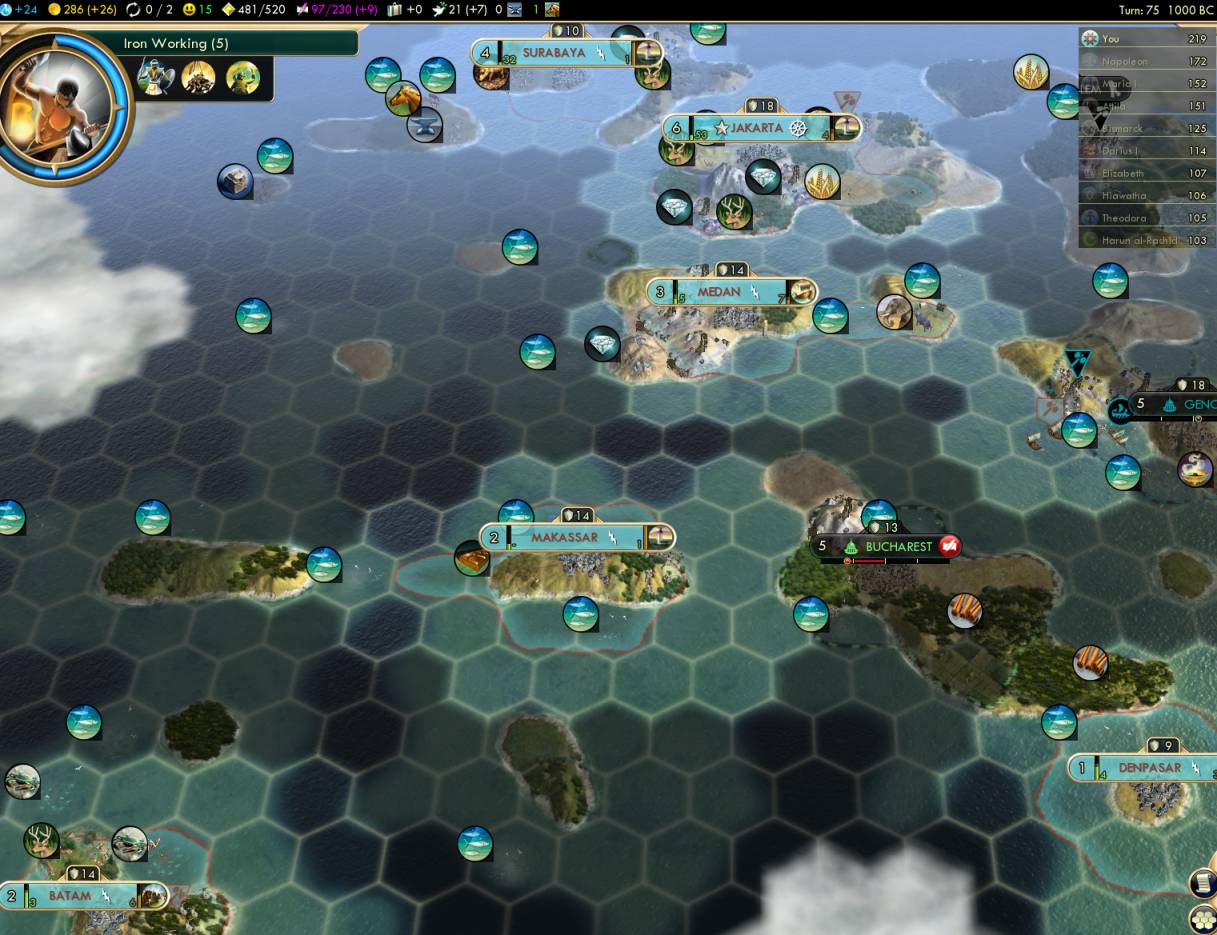
1000 BC overview. Out to six cities already -- and every one of them has a unique luxury, even before Indonesia's extras. I'm running at +15 happy and I can't even get down enough cities to use it all. Definitely hurtling full speed towards Protectionism. Running up to Iron Working to get that Colossus started now. I got the wonder on turn 88, after being a bit worried as someone had gotten IW before me.
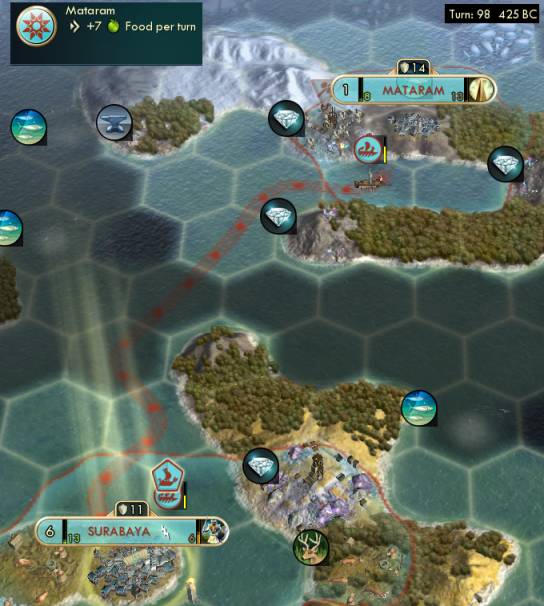
Food trade routes were still useful, situationally depending on the city. This guy here would struggle mightily on his own, but with a food trade route, would easily grow enough to work all those gems.
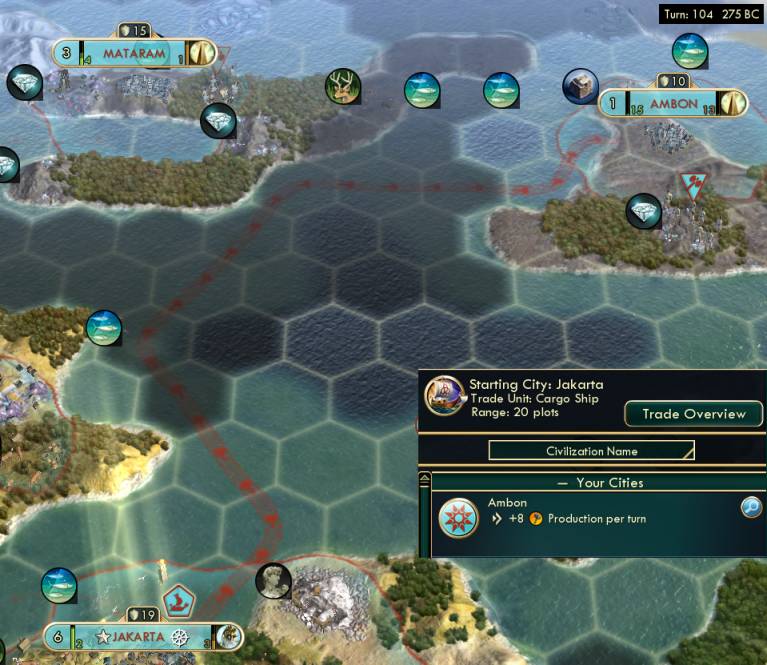
But the real prize was Metal Casting for those production trade routes. I got there on turn 102, bought the workshop in Jakarta, and started dishing out production trade routes. And right on the same turn got my sixth policy for the Commerce opener.
Why so hot on production trade routes? They work considerably better for bootstrapping island cities than what might seem to be the more obvious food routes. You need both, but production begets food and not the other way around. Production can build granary, aqueduct, monument to acquire fish tiles, lighthouse. Food does not beget production when there are no hills to work, and when there is no Slavery civic to whip.
This was an immensely satisfying opening. I played it up to this point in a single rollicking one-more-turn session that drove past 4 AM on a work night. Everything clicked into place together perfectly. My expansion rode just behind the happy curve all the way up, easily adding city after city as each new luxury got improved. All the cities had 3-5 good tiles to work which was just the right size without the Tradition food. I also finally (after several games going back to vanilla) realized to just buy all the 3rd-ring fish tiles; for some reason the culture picker always takes 2nd ring coast over 3rd ring fish, even though the prices are the same, they're not equal priority.

Midgame tech: Guilds then Physics for Machu Picchu and Notre Dame, then finally up to Compass to build harbors. Got that on T136 520 AD, slower than Morocco's 1 AD, but doing much better overall. This much better:
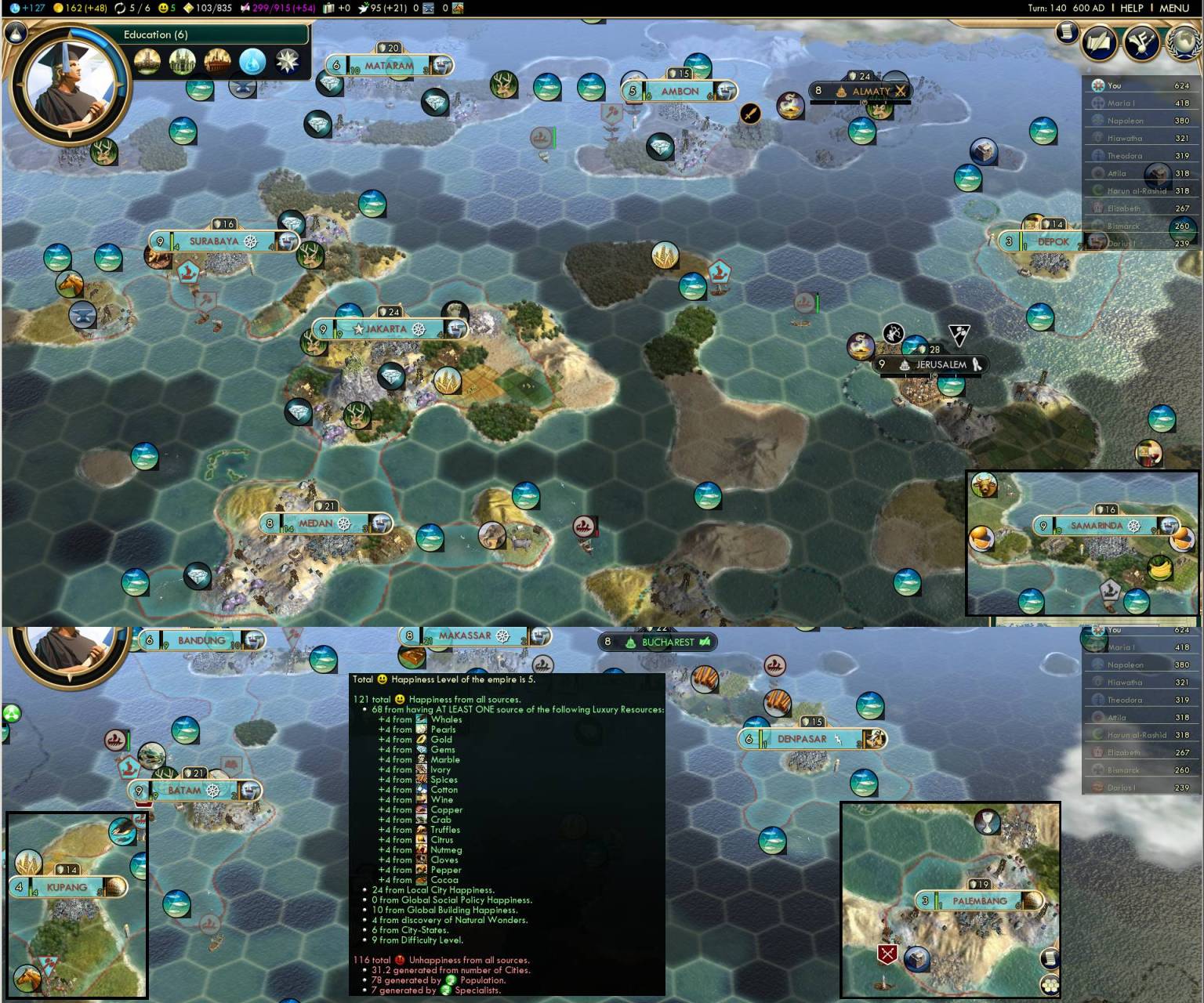
A big overview, awkwardly spliced together to show all of my cities since Civ 5 still can't pull the camera far enough out for a proper panorama. And a look at the enormously wide raft of happy resources I accumulated. Now that is how to build wide.
In fact, it's pretty definitely the most satisfying wide build I've ever had in Civ 5. I'd done wide builds before, but they mostly felt like ICS for the sake of ICS. This time I was actually building all the cities because I wanted to and because they felt like good strategic plays, capturing ever more resources. We comment about how Civ 5 is an empire-building game that punishes you for building an empire... but that doesn't have to be true. With the right setup, you can go wide pretty well. I'm well aware that it's not really accomplishing anything that a thin build couldn't, but I was actually having quite a bit of fun with this.
Do note how this only became possible with the game expansions. In that list of luxuries, fully half of them didn't exist before Gods & Kings, starting with Copper and going all the way down. Only Wine and upwards existed in the vanilla game, making this approach much less possible.
I'm also making good money, 50/turn... but look at where it's coming from. 71/turn from other civs -- it's all luxury sales. That still just works better than anything else for income, better than the trade routes and far better than terrain. Although presently with harbors I finally got the city connections going -- which also make more money than trade routes, and shot me up over 100 income per turn.
I spent the cash mostly on settlers and workers still, but also slipped in some nicely leveraged purchases of maritime city-states. Maritime food still works as well as ever too, and renders food trade routes less useful in favor of production instead.
T143 Great Engineer from Jakarta's workshop. Manufactory would be +3 yield over a mundanely improved tile... or could save him for a 750H wonder at Big Ben, yeah I like 250 turn payback periods, oh wait I don't.

I had city states nagging me for a natural wonder forever. Finally found King Solomon's Mines Tundra Wasteland, apparently Solomon is Superman in the Fortress of Solitude.

As often happens, all my faith went into missionaries while they were cheaper during the medieval era, waiting on the enhancement prophet until the Renaissance when the opportunity cost of the missionaries becomes less and also there's enough cities with the religion to get some good leverage out of the enhancement. Unfortunately, I waited too long and missed out on both good happy follower beliefs (gardens and temples). That shot actually shows all of my remaining options, there's no scroll bar. Guruship is still pretty good though, especially for hammer-poor island cities.
I expanded out to an enormous count of 17 cities, then finally stalled out against the limits of happiness. Protectionism was still two policies away. Maybe I should have gone for the medieval era sooner to get here faster. But really the annoying part is how you can't meaningfully invest in any more than one tree that's not available from the start of the game. Commerce and Exploration would have good synergy for gold production... except that it's impossible to get enough policies to complete both of them. They start too late with a time window far too narrow for 12 policies before you want to move into ideologies instead.
And the other annoying part is all the junk in Commerce. Protectionism is spectacular, but requires going through three virtually blank policies to get there (free roads, Landsknechts, and double Great Merchant gold.) Exploration has less chaff, but the big prize (Treasure Fleets, +4 gold per trade route) is not quite so good. And both have lame finishers, Commerce adds +1 gold per trading post and Exploration reveals "hidden antiquity sites".
Anyway, I scuffled along having to micromanage cities to avoid growth for a long time. (The right approach is to stay at 0 happiness, don't dip to -1. So any city with room in the food box continues filling it up, while those with a full food box get Avoid Growth checked. This is how to keep cities pseudo-growing even if they can't actually grow. Then when you do find some happiness, lift the restraint and now cash in the accumulated food into new citizens.) But then my second Great Writer arrived and I bulbed both of them into the culture to claim Protectionism.
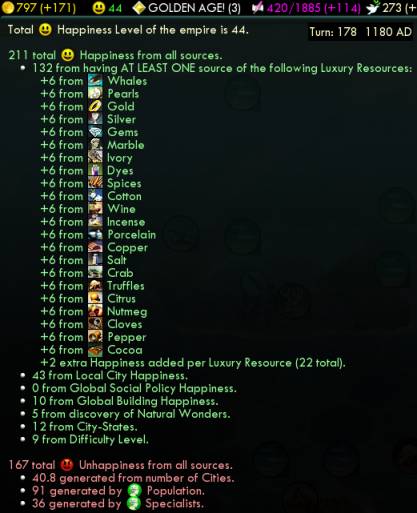
FORTY-FOUR happiness from the policy. Okay, that might indeed make up for the long string of chaff policies to get here. Yes, that's 22 unique luxuries -- in fact, every single one available on the map. (You can tell if you've got all the luxuries when a city requests a WLKTD resource that you already have, which it will only do if no other options remain.)
So I promptly bought four more settlers and dropped them down on yet more islands, coming to a total of 21 cities. I actually managed to blow through that 44 happiness surprisingly quickly, in about twelve turns.
I added some wonders. Notre Dame was obvious. Sistine Chapel was worthwhile to speed up policies -- and note that this makes amphitheatres important, since they become effectively +2 culture, since the math goes from 3 + 25% = 3.75 with Liberty and monument to 4 + 25% = 5. Also put in the Leaning Tower and Globe Theater for lack of anything else useful to build.
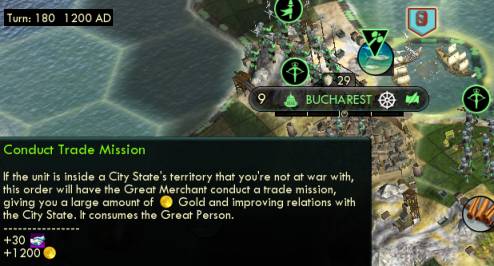
I got an unwanted but unavoidable Great Merchant as person #2 from the capital, thanks to the Colossus/Machu Picchu/Notre Dame wonders. I guess 1200 gold doubled by the Commerce policy isn't terrible, though it's still small change compared to a lightbulb for 5000+ beakers. At least this was timed perfectly to buy factories.
Presently I researched Industrialization and clocked Big Ben with the saved engineer. With the now 40% purchase discount, I immediately bought three factories to open the Ideology.
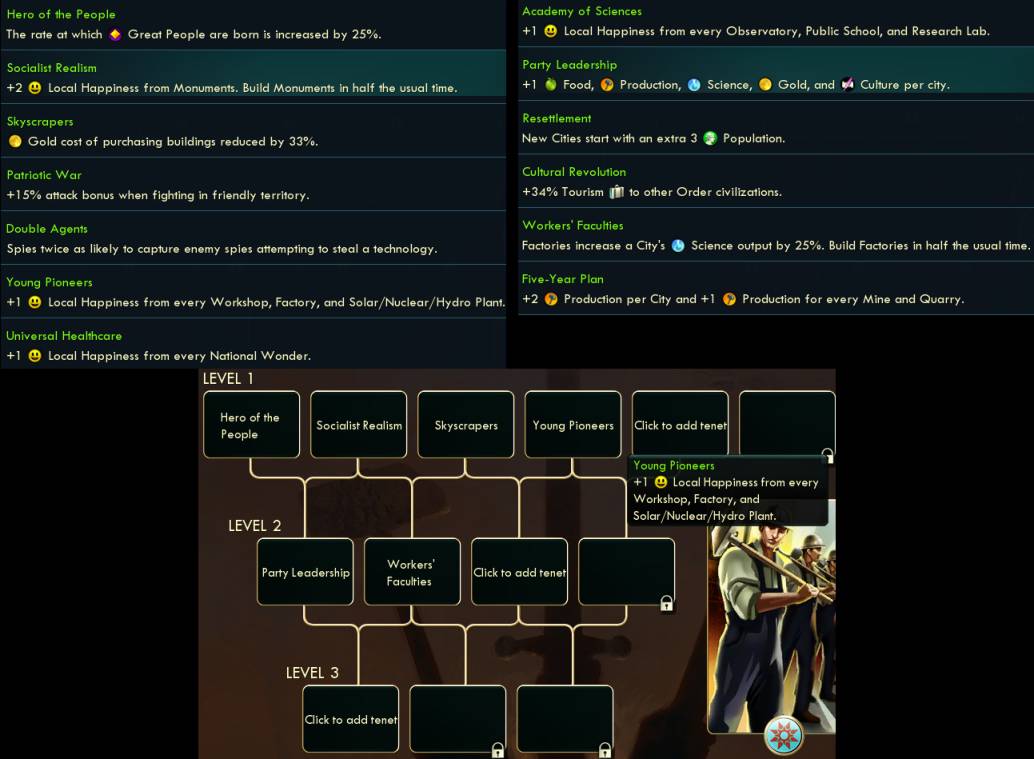
The recurring theme for policies and ideologies for the rest of the game was happiness. Protectionism had yielded 40 happy, but I managed to burn through that in barely a dozen turns of expanding and growing. I learned that lesson and took Socialist Realism as my second free tenet, but that 40 happy also burned within twenty turns. So then I belatedly took Meritocracy back in Liberty, for another 30 happy, that AGAIN depleted within twenty turns. Finally I took Young Pioneers for another 40 happy, which by this time I was finally done expanding so this time the happy actually lasted through endgame. The World's Fair was a great help in getting these policies, by both the free one and the doubled culture.
Between all that happiness, I also squeezed in Hero of the People for scientist GPP, and Party Leadership. I had a rare opportunity to make good use of that, with such a wide build with many newly established cities that could make use of that variety of production factors. I know Workers' Faculties is the more powerful play, but that actually came second just because Party Leadership looked more fun to play around with. Also I was short on coal for a while to take advantage of the factory discount.
The only level 3 tenet I needed was Spaceflight Pioneers, and of course that could wait until last. So then at long last, around turn 240 1700 AD, I could finally get into the Rationalism opener and Secularism. I did get the former soon enough to nab the Porcelain Tower.
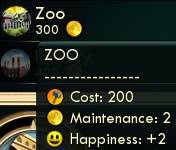
With each successive thrust of happiness from the Order ideologies, I dumped down several more settlers, getting out to a nice round total of 24 cities. I'm well aware these cities can't help the win, there's no mathematical way that city #21 can produce more than 5% of your total science. I just was playing a silly casual sandbox at this point, enjoying the ability to for once actually build a nice big wide empire in Civ 5. I actually stopped building cities when I wanted to, when all the good reachable sites were filled, not when the game forced me to.
And of course, the real star of this whole game plan was the Skyscrapers ideology. That -33% stacks multiplicatively with the mutually additive -25% and -15% discounts from Mercantilism and Big Ben, coming to a total discount of 60%, to buy buildings at 40% of face value. Now we can do gold:hammer conversion at a holy-crap efficient 1.5:1. Heck, this actually makes Trading Posts as valuable as mines.
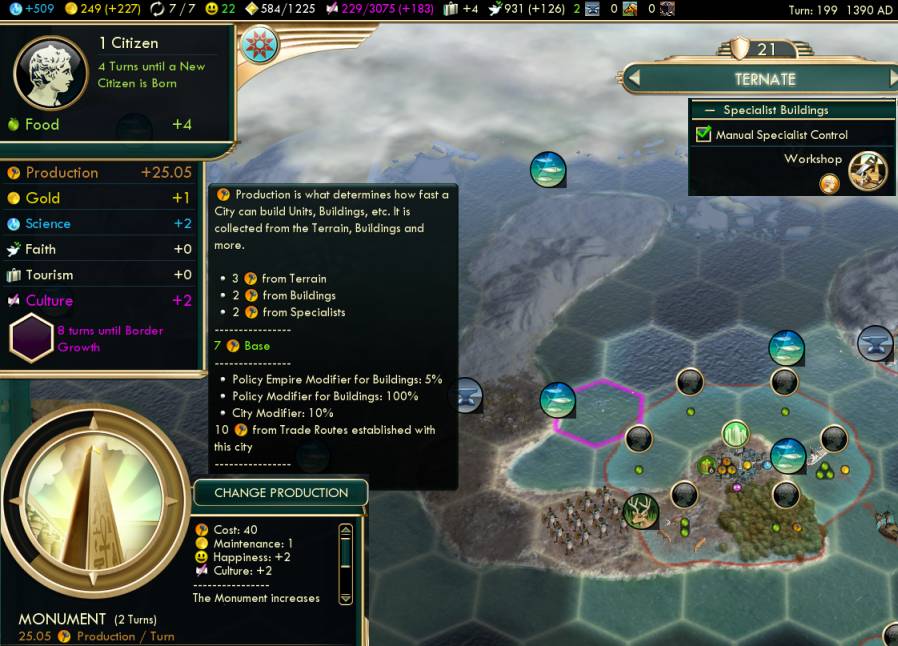
This all played very well into developing the new cities fast. I bought lots of infrastructure: the best values for a new city being the workshop to enable Guruship, then aqueduct, then a bit later Public Schools for midsize cities that built the university but the university's very presence (consuming citizens as scientists) makes it harder to build the public school. Then I saved money for research labs.
The new cities also each got a production trade route as soon as one came available. As I mentioned upthread, production is the way to go since that begets food and not the other way around.
As always happens in Civ 5, my core cities ran out of useful builds. This actually happens a good deal sooner in BNW. Because markets, banks, amphitheatres, opera houses, and theatres/zoos are all nerfed to near uselessness. The good builds were monument, lighthouse, granary, aqueduct, library, university, workshop, Candi (Indonesia UB Garden for +4 faith)... then the build options just fizzle out. Actually the right thing to do became work boats in the older cities to send to the newer. Work boats are usually terrible builds (50H for +1F) and I often go a whole game without ever building them, but that was the one useful way to spread production from old cities to new ones.
I built markets, banks, and stock exchanges anyway, just for lack of anything else, but they're not really worthwhile when there's no gold from coast to multiply. The total comes to 660 hammers and they add something like 16 gold to a city. Seemed barely worthwhile over building Research (which remember is only 25% effective in Civ 5 unlike 100% in Civ 4), but only barely.

30 turns after that last wave of cities, I finally switched the production trade routes over to gold. They were still underwhelming. Regular city income and connections and almost even luxury sales still outweighed the trade route income. I suppose trade routes work better for a smaller civ as the constant value is a bigger percentage, but overall this is still a very unsatisfying mechanic. And this is with every route being a sea route for doubled yield; the routes would be thoroughly underwhelming as land routes on another map. And I don't think the Exploration policy of +4 gold/route is nearly enough to be worth the sunk policies.
World Congress. I wanted Sciences Funding, but 5 civs would be angry, so went with World's Fair which pleased 5 civs. That's a fine place to sink hammers into and I won the fair easily.
Big final overview, as good as I can do with Civ 5's limited camera capabilities. Click for full size.

The endgame for a science victory in Civ 5 always revolves around managing the scientist bulbs. I've learned from past experience that you overshoot the tech tree if you save them all for the very end. The right rhythm is usually one bulb as soon as it will reach Plastics for Research Labs, then eight turns later another which will reach Rocketry to start Apollo Program which can be a long pole. Then after Apollo you can blow out the rest of the tech tree.
I lacked one source of scientists: faith purchases, since I never finished Rationalism. It's a significant change in BNW that Great Person faith purchases have been moved from the policy tree openers to the finishers. I mostly made up for that here by normal production via GPP, with so many cities to spawn them and also more time since this wasn't a fastest-finish race. Also the Indonesia UB (Garden buildable everywhere) helped. So my faith did pile up with nothing much relevant to spend it on. Didn't care about missionary or prophet spreading now. The only place to go was Great Merchants thanks to the Commerce finisher, so I guess that was better than nothing, though by now I was running out of useful ways to spend gold as well.
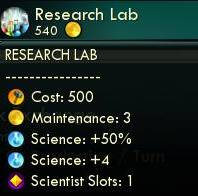
Anyway, on turn 233 I bulbed the first Great Scientist for 10300 beakers, to get Plastics. I'd saved 8000 gold over a dozen turns, and crash-bought a dozen Research Labs immediately, at an absurdly cheap price of 540 gold which is a conversion of 1.08 per hammer. Then filled in the rest over the next dozen turns, far more time-efficient to buy these than build.
I'm always startled by just how much of a jump the research labs make. That first bulb was 10k beakers, but then after the labs and Secularism the rest were 25k each! With that huge bulb value, I overshot the end of the tech tree anyway, with three scientists going to waste and the Hubble Telescope never built. I had thought that the cost escalation per city in BNW would prolong the end of the tech tree, but that didn't really happen.
Anyway, much micromanagement ensued around assigning specialists and production trade routes and buying SS factories for maximum hammers. Added the policies late of Five-Year Plan (+2 production/city), Spaceflight Pioneers from the Kremlin, and Iron Curtain with the very last policy for a few extra trade route hammers. Some scrambling ensued when I learned the Great Engineer from Spaceflight Pioneers does not complete a SS part all the way (it's only 300 + 30*pop, same as for a wonder), but I salvaged that without losing any turns.

Science Victory T273 1806 AD.
Not a lot of postgame commentary to add. Just again that the trade routes aren't a particularly shining mechanic, even in a game meant to focus on them. Although it might be a plus that the power level doesn't overwhelm everything else in the later game (that means you Civ 4 Corporations.)
Well, one other thing: The Order ideology really does work, to grant a ton of happiness for the ability to expand wide, and also provides the tools to build up those cities well. Such a plan still doesn't help on finish date, but at least the ability to build wide in Civ 5 now really does exist, and as a natural strategic flow rather than forced ICS for the sake of ICS.
I've still got more games of BNW to play, so there will be more.